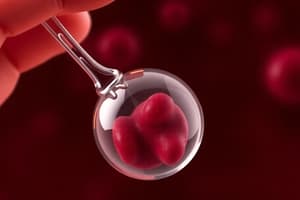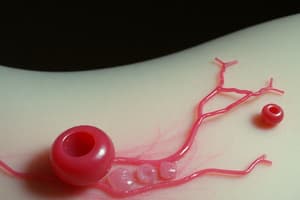Podcast
Questions and Answers
What are the potential consequences of an imbalance in thrombus formation and dissolution?
What are the potential consequences of an imbalance in thrombus formation and dissolution?
- Stroke or hypertension
- Infection or autoimmune disorders
- Excessive bleeding or thrombosis (correct)
- Increase in blood flow or anemia
What are the two stages of hemostasis?
What are the two stages of hemostasis?
- Primary and secondary (correct)
- Initial and final
- Primary and tertiary
- Secondary and quaternary
What is the primary risk associated with excessive bleeding due to hemostatic imbalance?
What is the primary risk associated with excessive bleeding due to hemostatic imbalance?
- Inadequate oxygen transport (correct)
- Enhanced healing processes
- Fluctuations in blood pressure
- Increased heart rate
Which of the following best describes the need for balance in thrombus formation and dissolution?
Which of the following best describes the need for balance in thrombus formation and dissolution?
How can an individual experience thrombosis?
How can an individual experience thrombosis?
Which process primarily involves the response of platelets and blood vessels to injury?
Which process primarily involves the response of platelets and blood vessels to injury?
What is a key characteristic of secondary hemostasis?
What is a key characteristic of secondary hemostasis?
What primarily triggers primary hemostasis following a vessel injury?
What primarily triggers primary hemostasis following a vessel injury?
Which of the following processes is NOT part of primary hemostasis?
Which of the following processes is NOT part of primary hemostasis?
Which component is mainly associated with secondary hemostasis?
Which component is mainly associated with secondary hemostasis?
Which proteins are predominantly found in active cells that contribute to their contractile capability?
Which proteins are predominantly found in active cells that contribute to their contractile capability?
What is a significant feature of active cells in terms of their ionic composition?
What is a significant feature of active cells in terms of their ionic composition?
In active cells, which molecule is primarily responsible for providing energy during contraction?
In active cells, which molecule is primarily responsible for providing energy during contraction?
Which of the following best describes the relationship between contractile proteins and energy in active cells?
Which of the following best describes the relationship between contractile proteins and energy in active cells?
Which of the following components would most likely be deficient in cells lacking active contractile proteins?
Which of the following components would most likely be deficient in cells lacking active contractile proteins?
What is the primary role of platelets during the process of platelet plug formation?
What is the primary role of platelets during the process of platelet plug formation?
Which component of the vascular injury initially attracts platelets to the site for plug formation?
Which component of the vascular injury initially attracts platelets to the site for plug formation?
What incorrect function may be associated with platelets during hemostasis?
What incorrect function may be associated with platelets during hemostasis?
During platelet plug formation, how do platelets contribute to the cessation of bleeding?
During platelet plug formation, how do platelets contribute to the cessation of bleeding?
Which of the following statements about platelet plug formation is false?
Which of the following statements about platelet plug formation is false?
What triggers platelet adhesion during the hemostatic process?
What triggers platelet adhesion during the hemostatic process?
Which process directly follows platelet adhesion in the hemostatic sequence?
Which process directly follows platelet adhesion in the hemostatic sequence?
What is the primary component that platelets adhere to during the adhesion phase?
What is the primary component that platelets adhere to during the adhesion phase?
Which of the following events does NOT occur during the early stages of hemostasis?
Which of the following events does NOT occur during the early stages of hemostasis?
What role do platelets play in clot retraction?
What role do platelets play in clot retraction?
Flashcards are hidden until you start studying
Study Notes
Hemostasis Overview
- Hemostasis maintains a delicate balance between thrombus (clot) formation and dissolution under normal conditions.
- Imbalance can lead to excessive bleeding or thrombotic events (vaso-occlusion).
Stages of Hemostasis
-
Primary Hemostasis:
- Involves the immediate response of platelets and blood vessels to injury.
- Rapid platelet adhesion and aggregation form a temporary plug.
-
Secondary Hemostasis:
- Involves coagulation factors responding to vessel injury.
- Objective is to reinforce the platelet plug with fibrin.
Platelet Activity
- Active platelets contain contractile proteins (actin, myosin, thrombosthenin) aiding in clot retraction.
- High calcium content and rich ATP levels enhance energy supply during hemostatic processes.
Platelet Adhesion Process
- Platelets adhere to exposed collagen beneath damaged endothelial cells in blood vessel walls.
- This interaction is crucial for initiating the formation of a platelet plug.
Formation of Platelet Plug
- Aggregation of platelets at the injury site is essential for stopping bleeding.
- Exposed collagen serves as an attractant for platelets, facilitating their collection and activation.
Studying That Suits You
Use AI to generate personalized quizzes and flashcards to suit your learning preferences.




